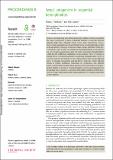Files in this item
Sexual antagonism in sequential hermaphrodites
Item metadata
| dc.contributor.author | Hitchcock, Thomas James | |
| dc.contributor.author | Gardner, Andy | |
| dc.date.accessioned | 2023-11-23T16:30:04Z | |
| dc.date.available | 2023-11-23T16:30:04Z | |
| dc.date.issued | 2023-11-29 | |
| dc.identifier | 295349326 | |
| dc.identifier | e7222563-37e7-42a6-8944-9ce348d78ca7 | |
| dc.identifier | 85177988619 | |
| dc.identifier.citation | Hitchcock , T J & Gardner , A 2023 , ' Sexual antagonism in sequential hermaphrodites ' , Proceedings of the Royal Society of London Series B: Biological Sciences , vol. 290 , no. 2011 , 20232222 . https://doi.org/10.1098/rspb.2023.2222 | en |
| dc.identifier.issn | 0962-8452 | |
| dc.identifier.uri | https://hdl.handle.net/10023/28759 | |
| dc.description | Funding: H2020 European Research Council - European Research Council Consolidator Grant (771387; Natural Environment Research Council - Independent Research Fellowship (NE/K009524/1); RIKEN - Special Postdoctoral Researchers Program; University of St Andrews - School of Biology PhD Scholarship | en |
| dc.description.abstract | Females and males may have distinct phenotypic optima, but share essentially the same complement of genes, potentially leading to trade-offs between attaining high fitness through female versus male reproductive success. Such sexual antagonism may be particularly acute in hermaphrodites, where both reproductive strategies are housed within a single individual. While previous models have focused on simultaneous hermaphroditism, we lack theory for how sexual antagonism may play out under sequential hermaphroditism, which has the additional complexities of age-structure. Here, we develop a formal theory of sexual antagonism in sequential hermaphrodites. First, we construct a general theoretical overview of the problem, then consider different types of sexually antagonistic and life-history trade-offs, under different modes of genetic inheritance (autosomal or cytoplasmic), and different forms of sequential hermaphroditism (protogynous, protoandrous or bidirectional). Finally, we provide a concrete illustration of these general patterns by developing a two-stage two-sex model, which yields conditions for both invasion of sexually antagonistic alleles and maintenance of sexually antagonistic polymorphisms. | |
| dc.format.extent | 9 | |
| dc.format.extent | 496052 | |
| dc.language.iso | eng | |
| dc.relation.ispartof | Proceedings of the Royal Society of London Series B: Biological Sciences | en |
| dc.subject | Sequential hermaphroditism | en |
| dc.subject | Protogyny | en |
| dc.subject | Protandry | en |
| dc.subject | Intragenomic | en |
| dc.subject | Conflict | en |
| dc.subject | Intralocus sexual conflict | en |
| dc.subject | QH301 Biology | en |
| dc.subject | T-DAS | en |
| dc.subject.lcc | QH301 | en |
| dc.title | Sexual antagonism in sequential hermaphrodites | en |
| dc.type | Journal article | en |
| dc.contributor.sponsor | European Research Council | en |
| dc.contributor.sponsor | NERC | en |
| dc.contributor.institution | University of St Andrews. School of Biology | en |
| dc.contributor.institution | University of St Andrews. Centre for Biological Diversity | en |
| dc.contributor.institution | University of St Andrews. Institute of Behavioural and Neural Sciences | en |
| dc.contributor.institution | University of St Andrews. St Andrews Bioinformatics Unit | en |
| dc.identifier.doi | 10.1098/rspb.2023.2222 | |
| dc.description.status | Peer reviewed | en |
| dc.identifier.grantnumber | 771387 | en |
| dc.identifier.grantnumber | NE/K009524/1 | en |
This item appears in the following Collection(s)
Items in the St Andrews Research Repository are protected by copyright, with all rights reserved, unless otherwise indicated.

